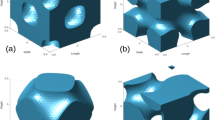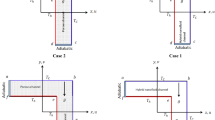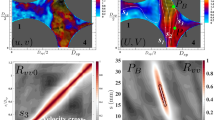Abstract
The modeling of flow and heat transfer in porous media systems has always been a challenge, and the extended Darcy transport models are used for macro-level analysis. However, these models are subjected to the limitations depending upon the porous geometry such as pore size, pore type, effective porosity, tortuosity, permeability, and the flow characteristics. The forced convective flow of an incompressible viscous fluid through a channel filled with four different types of porous geometries constructed using the Triply Periodic Minimal Surface (or TPMS) model is presented in this study. Four TPMS lattice shapes, namely Diamond, I-WP, Primitive, and Gyroid, are created with same volume fraction of solid subdomain as 0.68 (or void fraction as 0.32). Using different configurations for the solid subdomain by treating it as (a) solid, (b) fluid, and (c) porous zone, three different classes of porous structures are further generated for each TPMS lattice. The present study is executed with the objective to investigate the effect of shape–morphology, tortuosity, microporosity, and effective porosity on permeability and inertial drag factor. A pore-scale direct numerical simulation approach is performed for the first two types of porous media by solving the Navier–Stokes equations. The specific microporosity is quantitatively induced in the solid subdomain where Darcy–Forchheimer equation is solved, whereas the Navier–Stokes equations are solved for the void subdomain in the third type of porous media. The results reveal that Darcy flow regime exists up to the mean velocity value of U < 0.0025 m/s (Re < 10) for all the cases discussed here, and it deviates at the higher mean velocity. The conductance to the flow shown by Darcy number has the maximum and minimum values for the Primitive Type 2 and I-WP Type 1 cases. The inertial drag coefficient is minimum in Diamond lattice and maximum in Primitive lattice at lower porosity (0.32), while Primitive lattice has minimum and I-WP lattice has maximum value of inertial drag coefficient for higher porosity (~ 1).

















Similar content being viewed by others
Abbreviations
- a :
-
Unit cell size in x direction (m)
- a sf :
-
Specific interfacial area (m−1)
- A :
-
Cross-sectional area \((A = L^{2})\) (m2)
- b :
-
Unit cell size in y direction (m)
- c :
-
Unit cell size in z direction (m)
- C :
-
Level-set constant
- d p :
-
Pore or particle size (m)
- Da:
-
Darcy number \(\left(Da = \frac{K}{{L^{2} }}\right)\)
- K :
-
Permeability (m2)
- L :
-
Channel width or characteristic length (m)
- l :
-
Pore length scale (m)
- \(\dot{m}\) :
-
Mass flow rate (kg/s)
- n :
-
Normal distance from the surface (m)
- p :
-
Pore level pressure (Pa)
- P :
-
Average pressure (Pa)
- Re:
-
Channel size-based Reynolds number \(\left(\frac{\rho UL}{\mu }\right)\)
- Rep :
-
Pore-scale-based Reynolds number \(\left(\frac{\rho Ul}{\mu }\right)\)
- ReK :
-
Brinkman-scale-based Reynolds number \(\left(\frac{\rho U\sqrt K }{\mu }\right)\)
- u :
-
Pore level velocity in x direction (m/s)
- v :
-
Pore level velocity in y direction (m/s)
- w :
-
Pore level velocity in z direction (m/s)
- U :
-
Mean velocity in x direction (m/s)
- V :
-
Mean velocity in y direction (m/s)
- V f :
-
Volume of void subdomain (fluid zone) (m3)
- V s :
-
Volume of solid subdomain (m3)
- W :
-
Mean velocity in z direction (m/s)
- x :
-
X-Direction distance (m)
- y :
-
Y-Direction distance (m)
- z :
-
Z-Direction distance (m)
- X :
-
Lattice size in x direction (m)
- Y :
-
Lattice size in y direction (m)
- Z :
-
Lattice size in z direction (m)
- α :
-
Coefficient of cubic term
- β :
-
Coefficient of quadratic term
- ɛ :
-
Porosity
- ɛ o :
-
Porosity of the lattice
- ɛ * :
-
Micro-porosity
- ɛ eff :
-
Effective porosity of the lattice
- µ :
-
Dynamic viscosity of the fluid (kg/m-sec)
- µ * :
-
Effective viscosity of porous medium (kg/m-sec)
- \(\rho\) :
-
Density of the fluid (kg/m3)
- \(\tau\) :
-
Tortuosity
- solid:
-
Property of solid subdomain in the lattice
- void:
-
Property of void subdomain in the lattice
References
Adler, P.M., Thovert, J.-F., Mourzenko, V.V.: Fractured porous media. Oxford (2012)
Adler, P.M., Malevich, A.E., Mityushev, V.V.: Nonlinear correction to Darcy’s law for channels with wavy walls. Acta Mech. 224(8), 1823–1848 (2013)
Ali, M.S., Pandey, N., Hadj-Nacer, M., Greiner, M., Riyad, M.F.: Parametric study of two-phase flow in a porous wick of a mechanically pumped loop heat pipe. AIP Conf. Proc. (2021). https://doi.org/10.1063/5.0037715
Al-Ketan, O., Abu Al-Rub, R.K.: MSLattice: a free software for generating uniform and graded lattices based on triply periodic minimal surfaces. Mater. Des. Process. Commun. 3(6), 1–10 (2021). https://doi.org/10.1002/mdp2.205
Al-Ketan, O., Abu Al-Rub, R.K.: Multifunctional mechanical metamaterials based on triply periodic minimal surface lattices. Adv. Eng. Mater. 21(10), 1900524 (2019)
Al-Ketan, O., Abu Al-Rub, R.K., Rowshan, R.: The effect of architecture on the mechanical properties of cellular structures based on the IWP minimal surface. J. Mater. Res. 33(3), 343–359 (2018). https://doi.org/10.1557/jmr.2018.1
Almalki, W.S., Hamdan, M.H.: Investigations in effective viscosity of fluid in a porous medium. J. Eng. Res. Appl. 6(April), 41–51 (2016), [Online]. Available: www.ijera.com.
Bahrami, M., Yovanovich, M. M., Culham, J. R.: ICMM2005–75109, (2005).
Blunt, M.J., et al.: Pore-scale imaging and modelling. Adv. Water Resour. 51, 197–216 (2013). https://doi.org/10.1016/j.advwatres.2012.03.003
Bodla, K.K., Murthy, J.Y., Garimella, S.V.: Microtomography-based simulation of transport through open-cell metal foams. Numer. Heat Transf. Part A Appl. 58(7), 527–544 (2010). https://doi.org/10.1080/10407782.2010.511987
Breugem, W.P.: The effective viscosity of a channel-type porous medium. Phys. Fluids (2007). https://doi.org/10.1063/1.2792323
Carbonell, R.G., Whitaker, S.: Heat and mass transfer in porous media, In: Fundamentals of transport phenomena in porous media, pp. 121–198, Springer (1984)
Chen, C.K., Hung, C.I., Cleaver, J.W.: Non-Darcian effects on vertical-plate transient natural convection in porous media with high-porosities, 2(Ii), 313–318 (1987)
Chen, W., Ji, C., Alam, M.M., Williams, J., Xu, D.: Numerical simulations of flow past three circular cylinders in equilateral-triangular arrangements. J. Fluid Mech. (2020). https://doi.org/10.1017/jfm.2020.124
Cromwell, V., Kortum, D.J., Bradley, D.J.: The use of a medical computer tomography (CT) system to observe multiphase flow in porous media. Proc. SPE Annu. Tech. Conf. Exhib. 1984-Septe(1), 1–4 (1984). https://doi.org/10.2523/13098-ms
Dawe, R.A., Mahers, E.G., Williams, J.K.: Pore scale physical modeling of transport phenomena in porous media. Adv. Transp. Phenom. Porous Media (1987). https://doi.org/10.1007/978-94-009-3625-6_3
Deng, D., Liang, D., Tang, Y., Peng, J., Han, X., Pan, M.: Evaluation of capillary performance of sintered porous wicks for loop heat pipe. Exp. Therm. Fluid Sci. 50, 1–9 (2013). https://doi.org/10.1016/j.expthermflusci.2013.04.014
Dong, H., Blunt, M.J.: Pore-network extraction from micro-computerized-tomography images. Phys. Rev. Stat. Nonlinear Soft Matter. Phys. 80(3), 1–11 (2009). https://doi.org/10.1103/PhysRevE.80.036307
Elkins, C.J., Alley, M.T.: Magnetic resonance velocimetry: applications of magnetic resonance imaging in the measurement of fluid motion. Exp. Fluids 43(6), 823–858 (2007). https://doi.org/10.1007/s00348-007-0383-2
Ergun, S., Orning, A.A.: Fluid flow through randomly packed columns and fluidized beds. Ind. Eng. Chem. 41(6), 1179–1184 (1949)
ANSYS Fluent Tutorial Guide version 18, 15317(April), 724–746 (2018)
Forchheimer, P.: Wasserbewegung durch boden. Z. Ver. Deutsch Ing. 45, 1782–1788 (1901)
Gao, M.C., Miracle, D.B., Maurice, D., Yan, X., Zhang, Y., Hawk, J.A.: High-entropy functional materials. J. Mater. Res. 33(19), 3138–3155 (2018). https://doi.org/10.1557/jmr.2018.323
Givler, R.C., Altobelli, S.A.: A determination of the effective viscosity for the Brinkman-Forchheimer flow model. J. Fluid Mech. 258(1994), 355–370 (1994). https://doi.org/10.1017/S0022112094003368
Hadim, A.: Forced convection in a porous channel with localized heat sources (1994)
Hetsroni, G., Gurevich, M., Rozenblit, R.: Sintered porous medium heat sink for cooling of high-power mini-devices. Int. J. Heat Fluid Flow 27(2), 259–266 (2006). https://doi.org/10.1016/j.ijheatfluidflow.2005.08.005
Hill, R.J., Koch, D.L., Ladd, A.J.C.: Moderate-Reynolds-number flows in ordered and random arrays of spheres. J. Fluid Mech. 448, 243–278 (2001). https://doi.org/10.1017/s0022112001005936
Hommel, J., Coltman, E., Class, H.: Porosity–permeability relations for evolving pore space: a review with a focus on (Bio-)geochemically altered porous media. Transp. Porous Media 124(2), 589–629 (2018). https://doi.org/10.1007/s11242-018-1086-2
Hooman, K., Gorji-Bandpy, M.: Laminar dissipative flow in a porous channel bounded by isothermal parallel plates, Appl. Math. Mech. (English Ed.,) 26(5), 587–593 (2005). https://doi.org/10.1007/BF02466332
Jung, Y., Chu, K.T., Torquato, S.: A variational level set approach for surface area minimization of triply-periodic surfaces. J. Comput. Phys. 223(2), 711–730 (2007)
Kaviany, M.: Principles of heat transfer in porous media. Springer-Verlag New York, Inc. (1995)
Krishnan, S., Murthy, J.Y., Garimella, S.V.: A two-temperature model for solid-liquid phase change in metal foams. J. Heat Transf. 127(9), 995–1004 (2005). https://doi.org/10.1115/1.2010494
Launay, S., Sartre, V., Bonjour, J.: Parametric analysis of loop heat pipe operation: a literature review. Int. J. Therm. Sci. 46(7), 621–636 (2007). https://doi.org/10.1016/j.ijthermalsci.2006.11.007
Liu, S., Afacan, A., Masliyah, J.: Steady incompressible laminar flow in porous media. Chem. Eng. Sci. 49(21), 3565–3586 (1994). https://doi.org/10.1016/0009-2509(94)00168-5
Maydanik, Y.F.: Loop heat pipes. Appl. Therm. Eng. 25(5), 635–657 (2005). https://doi.org/10.1016/j.applthermaleng.2004.07.010
Mei, C.C., Auriault, J.L.: The effect of weak inertia on flow through a porous medium. J. Fluid Mech. 222, 647–663 (1991). https://doi.org/10.1017/S0022112091001258
Nield, D.A., Bejan, A.: Convection in porous media. Springer-Verlag New York, Inc. (2013)
Patankar, S.V., Liu, C.H., Sparrow, E.M.: Fully developed flow and heat transfer in ducts having streamwise-periodic variations of cross-sectional area. J. Heat Transf. 99(2), 180–186 (1977). https://doi.org/10.1115/1.3450666
Ranjan, R., Patel, A., Garimella, S.V., Murthy, J.Y.: Wicking and thermal characteristics of micropillared structures for use in passive heat spreaders. Int. J. Heat Mass Transf. 55(4), 586–596 (2012). https://doi.org/10.1016/j.ijheatmasstransfer.2011.10.053
Rojas, S., Koplik, J.: Nonlinear flow in porous media. Phys. Rev. E 58(4), 4776 (1998)
Sánchez-Palencia, E.: Non-homogeneous media and vibration theory, Lect. Notes Phys. 127 (1980)
Shah, R.K.: A correlation for laminar hydrodynamic entry length solutions for circular and noncircular ducts (1978)
Skjetne, E., Auriault, J.-L.: High-velocity laminar and turbulent flow in porous media. Transp. Porous Media 36(2), 131–147 (1999)
Vafai, K.: Analysis of the channeling effect in variable porosity media. J. Energy Resour. Technol. Trans. ASME 108(2), 131–139 (1986). https://doi.org/10.1115/1.3231252
Vafai, K., Amiri, A.: Non-Darcian Effects in Confined Forced Convective Flows. In: Ingham, D.B., Pop, I. (eds) Transport Phenomena in Porous Media, pp. 313-329. Pergamon (1998)
Valvatne, P.H., Piri, M., Lopez, X., Blunt, M.J.: Predictive pore-scale modeling of single and multiphase flow. Transp. Porous Media 58(1–2), 23–41 (2005). https://doi.org/10.1007/s11242-004-5468-2
Wang, C.Y.: A fixed-grid numerical algorithm for two-phase flow and heat transfer in porous media. Numer. Heat Transf. Part B Fundam. 32(1), 85–105 (1997). https://doi.org/10.1080/10407799708915000
Wang, S.Y., Ayral, S., Gryte, C.C.: Computer-assisted tomography for the observation of oil displacement in porous media. Soc. Pet. Eng. J. 24(1), 53–55 (1984). https://doi.org/10.2118/11758-PA
Ward, J.C.: Turbulent flow in porous media. J. Hydraul. Div. 90(5), 1–12 (1964)
Whitaker, S.: Diffusion and dispersion in porous media. AIChE J. (1967)
Whitaker, S.: Flow in porous media II: The governing equations for immiscible, two-phase flow. Transp. Porous Media 1(2), 105–125 (1986). https://doi.org/10.1007/BF00714688
Yang, X., et al.: Direct numerical simulation of pore-scale flow in a bead pack: comparison with magnetic resonance imaging observations. Adv. Water Resour. 54, 228–241 (2013). https://doi.org/10.1016/j.advwatres.2013.01.009
Yang, X., et al.: Intercomparison of 3D pore-scale flow and solute transport simulation methods. Adv. Water Resour. 95, 176–189 (2016). https://doi.org/10.1016/j.advwatres.2015.09.015
Acknowledgements
The first two authors Surendra Singh Rathore and Balkrishna Mehta would like to acknowledge the Indian Institute of Technology Bhilai for providing the computational and other peripheral resources through the institute research initiation grant.
Author information
Authors and Affiliations
Corresponding author
Additional information
Publisher's Note
Springer Nature remains neutral with regard to jurisdictional claims in published maps and institutional affiliations.
Appendix
Appendix
See Appendix Tables
10 and
11.
1.1 Equation for Momentum Conservation in porous media
-
a.
Darcy model (for low flow rates, \({\mathrm{Re}}_{p}\ll 1\))
$$\nabla p = - \frac{\mu }{K}\vec{V}$$(14) -
b.
Extended Darcy model (for intermediate to high flow rates)
$$\nabla p = - \frac{\mu }{K}\vec{V} - \frac{\rho \beta }{{\sqrt K }}\vec{V}\left| {\vec{V}} \right| - \frac{{\alpha \rho^{2} }}{\mu }\vec{V}\left| {\vec{V}} \right|^{2} \,\,\,\,\,\,\,\,(R{\text{e}}_{{\text{p}}} { > 1)}$$(15) -
c.
Brinkman extended Darcy model (for higher flow rates and high porosity, \(\varepsilon \to 1\))
$$\nabla p = - \frac{\mu }{K}\vec{V} - \frac{\rho \beta }{{\sqrt K }}\vec{V}\left| {\vec{V}} \right| - \frac{{\alpha \rho^{2} }}{\mu }\vec{V}\left| {\vec{V}} \right|^{2} + \mu^{*} \nabla^{2} \vec{V}$$(16)
In Eq. (16), \({\mu }^{*}\) is the effective viscosity of the porous medium and some important relations between the porosity and effective viscosity are mentioned in Table 10.
1.2 Calculation of Tortuosity
Tortuosity is calculated by taking two points in the direction of the flow and measuring actual length of flow path (length of fluid trajectory) and minimum length (length of straight line) between these two points. It is then defined as below:
Rights and permissions
Springer Nature or its licensor (e.g. a society or other partner) holds exclusive rights to this article under a publishing agreement with the author(s) or other rightsholder(s); author self-archiving of the accepted manuscript version of this article is solely governed by the terms of such publishing agreement and applicable law.
About this article
Cite this article
Rathore, S.S., Mehta, B., Kumar, P. et al. Flow Characterization in Triply Periodic Minimal Surface (TPMS)-Based Porous Geometries: Part 1—Hydrodynamics. Transp Porous Med 146, 669–701 (2023). https://doi.org/10.1007/s11242-022-01880-7
Received:
Accepted:
Published:
Issue Date:
DOI: https://doi.org/10.1007/s11242-022-01880-7




